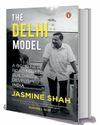
IN FEBRUARY 1946, sailors of the Royal Indian Navy rose in rebellion. Enraged by terrible working conditions, discrimination and neglect, as many as 20,000 men captured 78 ships and 21 shore establishments, and replaced British flags with that of the Congress, the Muslim League and the Communist Party of India. Ordinary people took to the streets to support the mutiny.
To quell it, the British sent warships and fighter planes. The ratings responded by training naval guns on the Gateway of India, Yacht Club and dockyards.
It was, writes award-winning publisher Pramod Kapoor, India’s last war of independence—one that hastened the end of the British Raj. But the details of the mutiny have been left out of popular narratives of India’s freedom struggle. After years of research, Kapoor has come out with a book that brings to light a forgotten chapter in India’s freedom struggle. Exclusive excerpts from 1946 Royal Indian Navy Mutiny: Last War of Independence:
BOMBAY WOKE TO what became the bloodiest day of the mutiny. On Friday (February 22, 1946), even as the political leadership turned their backs on the ratings, ordinary citizens took to the barricades to bravely face tanks and bullets in support of the strikers.
Newspaper reports estimated that somewhere between 350 to 700 people were killed and between 1,000 to 1,500 people were injured, some gravely.
Bu hikaye THE WEEK dergisinin May 01, 2022 sayısından alınmıştır.
Start your 7-day Magzter GOLD free trial to access thousands of curated premium stories, and 9,000+ magazines and newspapers.
Already a subscriber ? Giriş Yap
Bu hikaye THE WEEK dergisinin May 01, 2022 sayısından alınmıştır.
Start your 7-day Magzter GOLD free trial to access thousands of curated premium stories, and 9,000+ magazines and newspapers.
Already a subscriber? Giriş Yap

Forging the future
As the curtain falls on 2024, I take pride in the extraordinary milestones achieved under the leadership of Prime Minister Narendra Modi. This year stands as a testament to the Modi government's resolve to forge a resilient and forward-looking Bharat. From groundbreaking advancements in infrastructure to visionary global initiatives, these efforts resonate deeply with the vision of Viksit Bharat.

Our strange democracy
Abraham Lincoln is lauded as among the very best presidents the US ever had: the statesman par excellence successfully steered the nation through the devastating and perilous years of the American civil war. Not only did Lincoln manage to keep his country united, he also ensured the passage of the 13th amendment to the US constitution, which abolished slavery.

Five years of post-pandemic fashion
It has been five years since we discovered what Covid-19 was, and five years since it disrupted the world forever. The World Health Organization activated their emergency systems on January 1, 2020, and informed the world by January 4, 2020. By the end of that week, they had set guidelines for various countries to follow. Comparable to the Spanish flu of 1918, more than 7 million people have died of Covid according to official data. Unofficially, no one has an idea. WHO has just this week asked China to provide critical data to understand the virus's origins as a “moral and scientific imperative”.

Community spirit
Rhythm of Dammam opens a window to the world of African-origin Siddis of Uttara Kannada

'Breaking' down a scandal
Society Girl is not just a case study of a high-profile death in Pakistan but also a stark commentary on media trials

Progress card
Jasmine Shah's book tells you what the AAP has achieved in Delhi in the last 10 years

SENSE IN NONSENSE
In his latest book of poetry, Ruskin Bond is at his funniest

Get ready for Trump bump
The ‘butterfly effect’ is a beautiful, mysterious metaphor of the planet’s interconnectedness.

QUIET FLOWS THE FAITH
The melding of an ancient amorphous faith and the latest science; of an antique tradition and new practices; ways of life older than memory and new expressions is happening at Prayagraj in Uttar Pradesh.

Trash to treasure
How a weed-choked Dal Lake spurred Maninder Singh's journey to become a waste management visionary